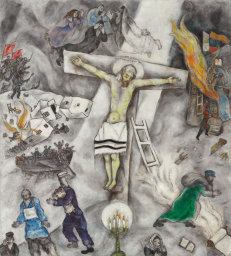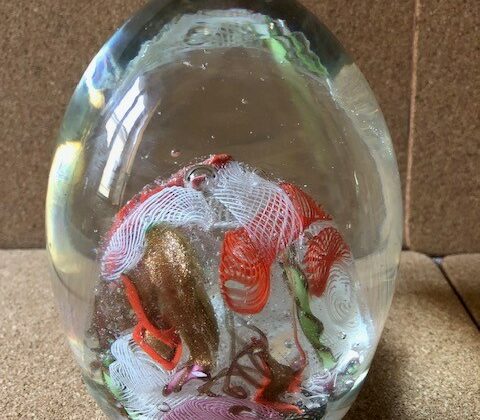Marc Chagall “A retrospective 1908-1985’
Prof. Francesco Carelli
Family Medicine, University of Milan, Rome
“Will the hurried men of today be able to penetrate her work, her world?” is the question asked by Marc Chagall in 1947 in the postface to the memoirs of his wife Bella, who left him “in the shadows” following her sudden death three years earlier.
However, this question could also be asked about his own work, the work of an artist who speaks such a universal language that he is loved by everyone alike, both young and old, men and women, scholars and men on the street. Chagall is an artist who is known and recognized by everyone and, out of all the 20th-century artists, was one of the few to remain faithful to himself despite living through a century of wars, catastrophes, political and technological upheavels.
The exhibition ‘Marc Chagall. Una retrospettiva 1908–1985’ is sponsored by the Municipality of Milan-Culture, organized and produced by Palazzo Reale, 24 ORE Cultura – Gruppo 24 ORE, Arthemisia Group.
The exhibition narrative has arisen from a question and a need: on the one hand, the attempt to understand the strength that enabled an artist who experimented with the styles of all the avant-garde movements, to remain so consistent to himself, always curious about the world around him, developing a style that can be recognized immediately by people of any age and any social status; on the other, the need to study Chagall’s work in order to identify the secret behind the poetry of this fragile man who was yet able to keep faith with his traditions and with his humanity, despite living in a world shaken to the core by indescribable and until then unimaginable catastrophes.
The exhibition is the biggest retrospective ever devoted to Marc Chagall in Italy, with over two hundred and twenty works – mainly paintings from 1908 onwards, when Chagall painted his first work Le Petit Salon, right up to his final, monumental works of the 1980s – which guide visitors through the artistic career of Marc Chagall. Works from the collections of his heirs, some of which have not been exhibited to the public before, feature alongside masterpieces from the world’s most important museums, including the MoMA,
he assimilates the great artists of tradition, from Rembrandt to the avant-garde artists whom he frequented so assiduously ). the Metropolitan Museum in New York, the National Gallery in Washington, the State Russian Museum in St Petersburg, the Centre Pompidou, and over fifty public and private collections.
The exhibition theme therefore focuses on a new interpretation of the language of Chagall, whose poetic vein developed throughout the 20th century out of a blend of the best western European traditions: from his original Jewish culture to the Russian culture and his encounter with French avant-garde painting.
The exhibition features a comprehensive chronological narrative, divided into sections, starting with his earliest works painted in Russia; his first visit to France and his subsequent return to Russia where he stayed until 1921; the second period of his exile, opened by the autobiography written by Chagall when he left Russia forever, living firstly in France and then, in the 1940s, in America where he endured the tragedy of the death of his beloved wife Bella; his return to France and his decision to settle permanently on the Cote d’Azur, where Chagall rediscovered his most relaxed poetic language, calmed by the colours and atmosphere of the south.
The exhibition provides visitors with an understanding of how, despite living in perennial exile, Chagall never lost hold of the thread that kept the child he used to be in his heart; how, over the years and throughout the terrible events that married his existence, he succeeded in preserving his sense of amazement, joy and wonder inspired by nature and humanity, as well as his strong faith that led him to believe in the possibility of a better world and seek to build it in all possible ways.
Visitors also discover his highly original poetic language, born out of the assimilation of the three cultures to which he belonged: Jewish culture (the visual tradition of its ornate manuscripts inspired the expressive, non-perspectival and sometimes mystic elements of his work); Russian culture (evident both in the folk images of the luboks and the religious images of the icons); western culture ( in which
They also observe his sense of wonder at nature and the amazement inspired by living creatures that places him closer to mediaeval sources than 20th-century ones.
In that same year of 1938 the Jewish artist Marc Chagall would complete a remarkable painting titled White Crucifixion. Here the artist depicts a crucified Christ, skirted with a tallith and encircled by a kaleidoscopic whirl of images, that narrates the progress of a Jewish pogrom. The skewed, tau-shaped cross extends toward the arc of destruction and bears particular meaning in that context. Whatever the cross of Christ may mean, in 1938 it was circumscribed by the realities of Holocaust: the onrush of a weapons-bearing mob overruns houses and sets them aflame; a group of villagers seeks to flee the destruction in a crowded boat, while others crouch on the outskirts of the village; an old man wipes the tears from his eyes as he vanishes from the picture, soon to be followed by a bewildered peasant and a third man clutches a Torah to himself as he witnesses over his shoulder a synagogue fully ablaze.
Chagall’s juxtaposition of crucifixion and the immediacy of Jewish suffering creates an intense interplay of religious expectation and historical reality that challenges our easy assumptions. He does not intend to Christianize the painting, certainly not in the sense of affirming any atoning resolution of the Jewish plight. Rather, in the chaotic world of White Crucifixion all are unredeemed, caught in a vortex of destruction binding crucified victim and modern martyr. As the prayer shawl wraps the loins of the crucified figure, Chagall makes clear that the Christ and the Jewish sufferer are one.
Flowers and animals are a constant presence in his paintings, enabling him on the one hand to overcome the Jewish interdiction of human depiction, while on the other becoming metaphors for a possible world in which all living beings can live in peace as in Russian mediaeval culture. In the words of Giovanni Arpino: “The soul of Chagall is a bleating soul, as mild as it is invincible because it escapes the horrors, the snares, the outrages … His paradise is an earthly Otherworld that encompasses the simulacra of life, a physical place that becomes metaphysical precisely because we have all killed it during daily life.”
His art constitutes a sort of metissage between cultures and traditions. The fundamental key to his modernity lies in his desire to transform contamination into a value, a work of art into a language able to ask questions that have as yet been left unanswered by mankind.
 |



